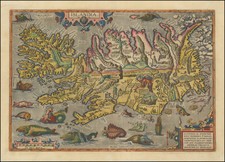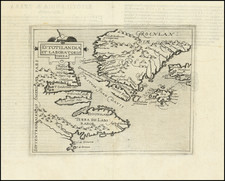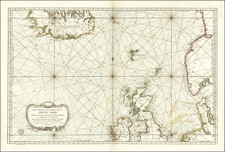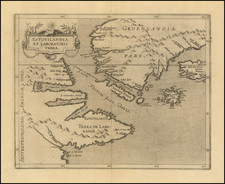Wonderful early automobile road map for Iceland, published by the Geodetic Institute in Copenhagen and Reykjavik in 1930. This example sold by Stanford of London.
The key is in Icelandic, Danish, and English. The maps show auto roads, bridle paths, and indistinct paths.
Interestingly, the island could not be circumnavigated with an automobile in 1930.
In the 1986 volume of Annals on Glaciology, Haukur Tomasson, wrote "The History of Mapping in Iceland, with Special Reference to Glaciers". In that article he writes of the Geodetic Institute's work:
Modern mapping was started in the beginning of this century. The driving force for this mapping was the Icelandic need for better maps, especially nautical ones. The initial funding was provided by the Icelandic Parliament, but later financing came from the Danish state, which paid a greater part of the cost. To begin with, in 1902-14 and 1920, the contractor was Generalstabens Topografiska Avdeling, in Copenhagen. A new triangulation network was surveyed and detail mapping was carried out by a plane-table method on a scale of 1:50 000 and later 1:100 000. The work, proved to be much more time-consuming and expensive than originally expected and so was abandoned for a decade.
In 1930, the work was resumed, this time with the Geodetic Institut in Copenhagen as a contractor. At first, the same methods were used as earlier, i.e. plane-table measurements. But the progress was slow and therefore it was decided to finish it with photogrammetry, using oblique aerial photographs. The photographs were taken in 1937 and 1938 by the Danish Air Force, The photogrammetric work was carried out in Copenhagen and was finished in 1944.
This survey provided a map, on a scale of 1:100 000, of the whole country, with contour lines at 20 m intervals. On the main glaciers, these are called form lines. The maps were published by the Geodetic Institut, in Copenhagen and Reykjavik and later by Landmælingar Islands (Iceland Geodetic Survey), These maps and others on a smaller scale, based on the same survey, can be purchased in book stores and tourist shops.
These maps gave much more detailed knowledge of the geographical features of the country. In glaciology, the maps are of interest because they show the position of the southern outlet glaciers of Vatnajökull at the time of mapping, which was just after the turn of the century, and the position of glacier snouts in the interior highlands in 1937-38.
The last general mapping covering all Iceland was done by the U.S. Army Map Service, in the year 1948-49. This mapping was photogrammetric and is based on vertical aerial photographs, mainly dating from 1946-47. The map is mostly based on the Geodetic Institut survey, for ground control. The scale is 1:50 000 and the contour interval is 20 m. This mapping was done for the American Army and ?s stamped “security information”. The map is a great improvement with regard to contour form and is widely used in technical and scientific institutions.
















![[ Iceland ] Isola d'Islanda](https://storage.googleapis.com/raremaps/img/small/98962.jpg)